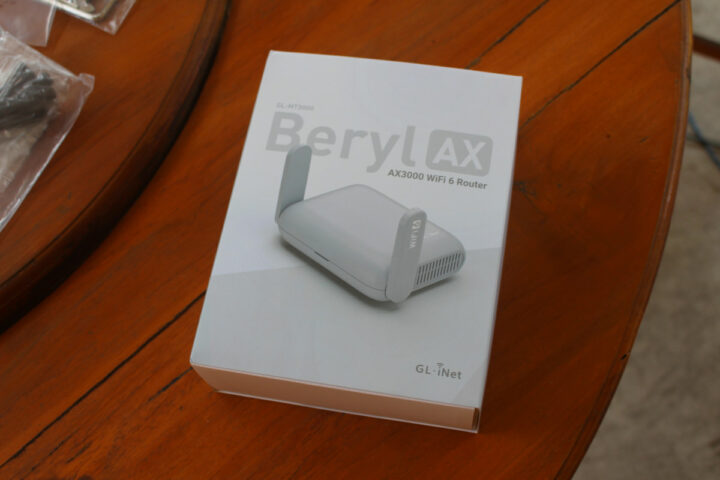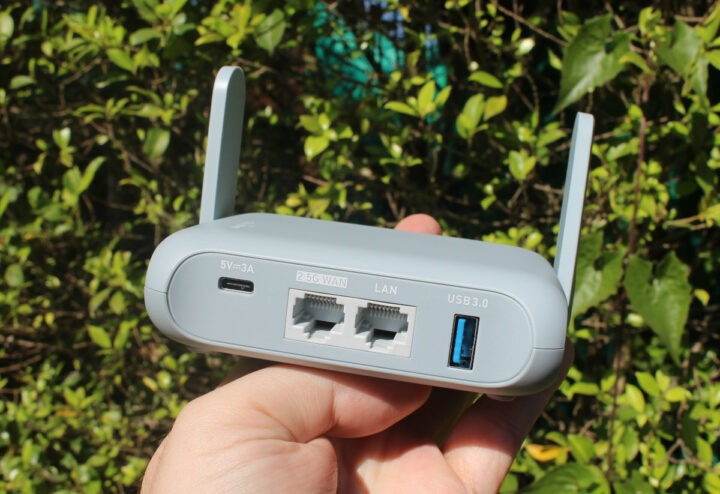GL.iNet Beryl AX (GL-MT3000) is a pocket-sized Wi-Fi 6 router running OpenWrt on a MediaTek MT7981B (Filogic 820) dual-core processor @ 1.3 GHz and equipped with a 2.5GbE port, a Gigabit Ethernet port, and a USB 3.0 port.
The hardware is basically the same as the Brume 2 (GL-MT2500A) security gateway, except it adds support for WiFi 6 connectivity and as an AX3000 router more than doubles the bandwidth compared to the earlier Beryl (GL-MT1300) AC1300 router. The company has sent me a sample so I’ll start the two-part review by checking the specifications, doing an unboxing, and tearing it down to have a closer look at the hardware design, before trying out OpenWrt and testing WiFi 6 and 2.5GbE performance in the second part of the review.
GL.iNet GL-MT3000 specifications
Beryl AX specifications:
- SoC – MediaTek MT7981B (Filogic 820) dual-core processor @ 1.3 GHz
- System Memory – 512MB DDR4
- Storage – 256MB NAND flash
- Networking
- 1x 2.5 Gbps Ethernet WAN port
- 1x Gigabit Ethernet LAN port
- 802.11b/g/n/ac/ax WiFi 6 with 2x retractable external Wi-Fi antennas
- Up to 574Mbps @ 2.4 GHz
- Up to 2402Mbps @ 5 GHz
- DFS (Dynamic Frequency Selection) support
- WPA3 security
- VPN – OpenVPN tested up to 150 Mbps, and WireGuard tested up to 300 Mbps over Ethernet in client mode (by GL.iNet)
- USB – 1x USB 3.0 Type-A port, 1x USB Type-C port for power
- Misc – Reset button, toggle button for customized features (e.g. Wireguard on/off defined in the Admin Panel), and status LEDs
- Power Supply – 5V/3A via USB Type-C port
- Power Consumption – <8W
- Temperature Range – Operating: 0 ~ 40°C; storage: -20 ~ 70°C
- Dimensions – 106 x 83 x 33mm (plastic enclosure)
- Weight – 196 grams
The router runs OpenWrt 21.02 with Linux 5.4. The firmware, mobile app, and detailed documentation are provided by the company. Note that both the system memory (512MB vs 1GB) and storage (256MB NAND vs 8GB eMMC) have much lower capacities than in the Brume 2, so some of the features may be missing, albeit the company still lists WireGuard, OpenWrt, and AdGuard Home, so we’ll find out when testing the software part. The router also consumes more and is quite heavier than the Brume 2, even than the “A” model with a metal enclosure. We’ll find out why in the teardown section.
Beryl AX unboxing
Let’s open the package to take out the router together with a 5V/3A USB-C power supply along with US, EU, and UK plug adapters, and some basic documentation, as well as a Thank You card showing coupon “THANKS10” for a 10% discount on the next purchase on the GL.iNet store.
We’ll find the USB Type-C power input, 2.5GbE and GbE ports, as well as the USB 3.0 port on the rear panel,
and if we adjust the external antennas vertically – as they should be during operating – we’ll see the reset and toggle buttons.
There’s also a status LED at the front of the device not shown in the photos above.
GL-MT3000 router teardown
We’ll need to remove the rubber pads and loosen the four screws underneath to open the enclosure for the “GL.iNet AX3000 WiFi 6 Router”. Note there’s a depression under the sticker, but there aren’t any screws there.
I had to use a tool to unclip the top parts of the case. The biggest surprise to me is the presence of a fan on a fairly large and thick heatsink as I don’t think I have ever seen a router that’s not fanless. That explains the larger weight, and it should not have been that surprising since I was told last year that WiFi 6 (802.11ax) consumes a lot of power and cooling can be challenging.
Besides two wires to the external antennas, we can also find an additional internal antenna.
If we turn the device around, a 4-pin UART header for console access can be seen, and the fan comes with more than two wires so it should be controlled with PWM and not always on. I tried to take out the board, but it did not come that easily, and I did not want to mess around with the thermal solution before testing the router, so I stopped there. GL.iNet does provide an internal photo with clear markings.
It turns out the internal antenna is for 5GHz WiFi, while the two external antennas are used for both 2.4 GHz & 5GHz WiFi. The 2.5GbE port is implemented through an MXL (MaxLinear) Ethernet PHY that should probably be the GPY211.
That will be all for today, the next step will be to connect the router and check out OpenWrt and its main features, especially WiFi 6, as the rest will be similar to the Brume 2. I’d like to thank GL.iNet for sending the GL-MT3000 “Beryl AX” pocket-sized router for review. It’s not available for sale just yet, but you can register your interest on the product page if you’d like to purchase the router at launch.
Continue reading “GL.iNet Beryl AX OpenWrt router review – WiFi 6 performance, repeater, NAS, and 4G hotspot modes“.

Jean-Luc started CNX Software in 2010 as a part-time endeavor, before quitting his job as a software engineering manager, and starting to write daily news, and reviews full time later in 2011.
Support CNX Software! Donate via cryptocurrencies, become a Patron on Patreon, or purchase goods on Amazon or Aliexpress












